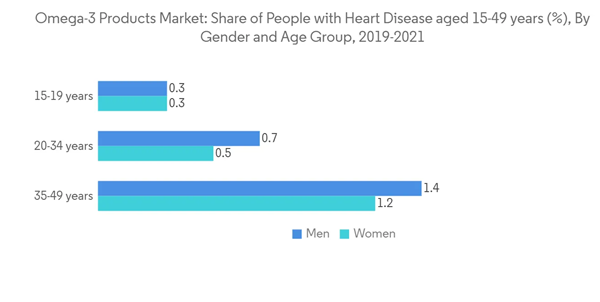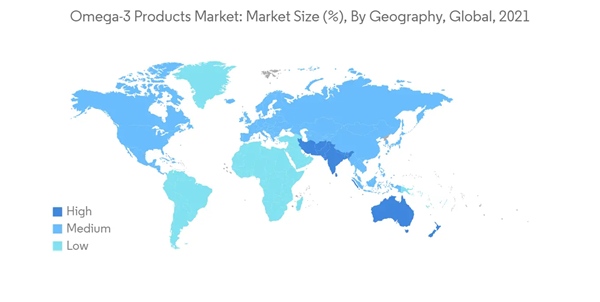The Omega-3 Products Market size is estimated at USD 47.77 billion in 2024, and is expected to reach USD 68.86 billion by 2029, growing at a CAGR of 7.59% during the forecast period (2024-2029).
Omega-3 is known to have many health benefits. Consequently, the COVID-19 pandemic created opportunities for manufacturers of health-oriented products, especially dietary supplements containing omega-3. Due to this, consumers are recently more inclined towards consuming nutritional supplements daily to prevent themselves from severe respiratory syndrome like coronavirus. It is leading to a massive increase in the demand for omega 3 supplements, boosting the omega 3 product market.
Recently, deaths from cardiovascular disease witnessed to increase around the globe, which tends to boost the omega-3 product market. Western Sub-Saharan Africa and South Asia saw a rise in cardiovascular disease. Omega-3 fatty acids found in supplements and naturally in foods such as certain fish, nuts, and seeds, have long been touted for health benefits, especially heart health. However, increasing chronic diseases like heart disease, arthritis, strokes, and cancer are predicted to accelerate the demand for omega-3 products over the globe. As per the World Health Organization (WHO), more than 14 million people aged 30 and 70 die yearly from eminent chronic diseases.
Further, the rising application of omega-3 fatty acids in pet food and pharmaceuticals is highly boosting the market owing to the increasing public initiatives syndicated with health and fitness, which further aid the market. The growing awareness among consumers about omega-3 health benefits is driving the demand for innovation among the market players to sustain. However, the technology delivers odorous oils in a micro-emulsified formulation designed to increase surface absorption. The OmegaZero® Technology helps the odoriferous oil get emulsified in the gut instead of forming a layer on the gastric juice, thus, significantly reducing the oil contact surface with air.
Omega-3 fatty acids also help ward off many eye diseases and help treat dry eye syndrome. Studies show that consuming omega-3 fatty acids, whether in foods or supplements, may help reduce your risk of developing macular degeneration and glaucoma. Therefore, the benefits of omega-3 in various aspects of human health are expected to drive its demand in the market.
Additionally, the shift among pet owners to take extra care in choosing pet products positively affected omega-3-based pet foods. Many manufacturers are providing pet foods containing essential nutrients like Eukanuba. Proactive Health for Small Breeds is an easily digestible protein-rich food containing omega-3 for healthy skin and a radiant coat. It is widely available in the Japanese market. Thus, the growing demand for omega-3 in various regional products is propelling its demand in the regional market.
This product will be delivered within 2 business days.
Omega-3 is known to have many health benefits. Consequently, the COVID-19 pandemic created opportunities for manufacturers of health-oriented products, especially dietary supplements containing omega-3. Due to this, consumers are recently more inclined towards consuming nutritional supplements daily to prevent themselves from severe respiratory syndrome like coronavirus. It is leading to a massive increase in the demand for omega 3 supplements, boosting the omega 3 product market.
Recently, deaths from cardiovascular disease witnessed to increase around the globe, which tends to boost the omega-3 product market. Western Sub-Saharan Africa and South Asia saw a rise in cardiovascular disease. Omega-3 fatty acids found in supplements and naturally in foods such as certain fish, nuts, and seeds, have long been touted for health benefits, especially heart health. However, increasing chronic diseases like heart disease, arthritis, strokes, and cancer are predicted to accelerate the demand for omega-3 products over the globe. As per the World Health Organization (WHO), more than 14 million people aged 30 and 70 die yearly from eminent chronic diseases.
Further, the rising application of omega-3 fatty acids in pet food and pharmaceuticals is highly boosting the market owing to the increasing public initiatives syndicated with health and fitness, which further aid the market. The growing awareness among consumers about omega-3 health benefits is driving the demand for innovation among the market players to sustain. However, the technology delivers odorous oils in a micro-emulsified formulation designed to increase surface absorption. The OmegaZero® Technology helps the odoriferous oil get emulsified in the gut instead of forming a layer on the gastric juice, thus, significantly reducing the oil contact surface with air.
Omega-3 Products Market Trends
Health Benefits Associated With Omega-3 Consumption
Omega-3 fatty acids, particularly EPA and DHA, are essential in the human diet for proper growth, development, and good health. They are suitable for heart health, joint and inflammation support, eye health, cognitive function, pregnancy and child development, and immune function. It is known that omega-3 reduces cardiovascular disease risk. Recently, deaths from cardiovascular disease witnessed an increase globally. Western Sub-Saharan Africa and South Asia saw a rise in cardiovascular disease. According to the United Nations Population Fund (India), the number of cases of heart disease in senior citizens across India in 2050 is expected to be 19.1 million. Countries such as India and China, where chances of heart disease cases are increasing, create demand for heart health products, which supports the omega-3 products market.Omega-3 fatty acids also help ward off many eye diseases and help treat dry eye syndrome. Studies show that consuming omega-3 fatty acids, whether in foods or supplements, may help reduce your risk of developing macular degeneration and glaucoma. Therefore, the benefits of omega-3 in various aspects of human health are expected to drive its demand in the market.
Asia-Pacific Dominates the Global Omega-3 Products Market
The shift in consumer preference toward a healthy diet comprising omega-3 ingredients and the use of fish oil in Asia-Pacific is expected to boost sales. China is the third-largest market for EPA and DHA oils in the world. Consumers in China primarily obtain their omega-3s from fish, supplements, and fortified foods. Omega-3 sourced from fish oil dominates the dietary supplements sector, while algal DHA oil leads in the fortified food and beverage industry. Cooking oil, eggs, and health drinks are popular fortified omega-3 products in the Indian market. Over the years, consumer demand increased, and several major companies have started selling omega-3 supplements and other products on e-commerce websites.Additionally, the shift among pet owners to take extra care in choosing pet products positively affected omega-3-based pet foods. Many manufacturers are providing pet foods containing essential nutrients like Eukanuba. Proactive Health for Small Breeds is an easily digestible protein-rich food containing omega-3 for healthy skin and a radiant coat. It is widely available in the Japanese market. Thus, the growing demand for omega-3 in various regional products is propelling its demand in the regional market.
Omega-3 Products Industry Overview
The omega-3 products market is moderately consolidated with various primary and local players. Some key players in the market are Reckitt Benckiser Group PLC, Sanofi SA, Unilever PLC, Amway Corp., Nestle SA, and several small-scale private-labeled local manufacturers. Most of the companies operating at the regional level are private companies. Thus, their market prominence is less than the other prominent players in the market studied. Most of the major players in the omega-3 product industry are focusing on Research Development for the latest product innovation, merger, and acquisition, which is expected during the forecast period. Advanced distribution networks and manufacturing expertise give an upper edge to the manufacturers to expand their range of products.Additional Benefits:
- The market estimate (ME) sheet in Excel format
- 3 months of analyst support
This product will be delivered within 2 business days.
Table of Contents
1 INTRODUCTION
4 MARKET DYNAMICS
5 MARKET SEGMENTATION
6 COMPETITIVE LANDSCAPE
Companies Mentioned (Partial List)
A selection of companies mentioned in this report includes, but is not limited to:
- Nestle SA
- Unilever
- Amway Corp.
- Sanofi SA
- Herbalife Limited
- Quadra Chemicals Inc.
- Reckitt Benckiser Group PLC
- Blackmores Limited
- Natures Crops International
- Cooke Inc.
Methodology

LOADING...










